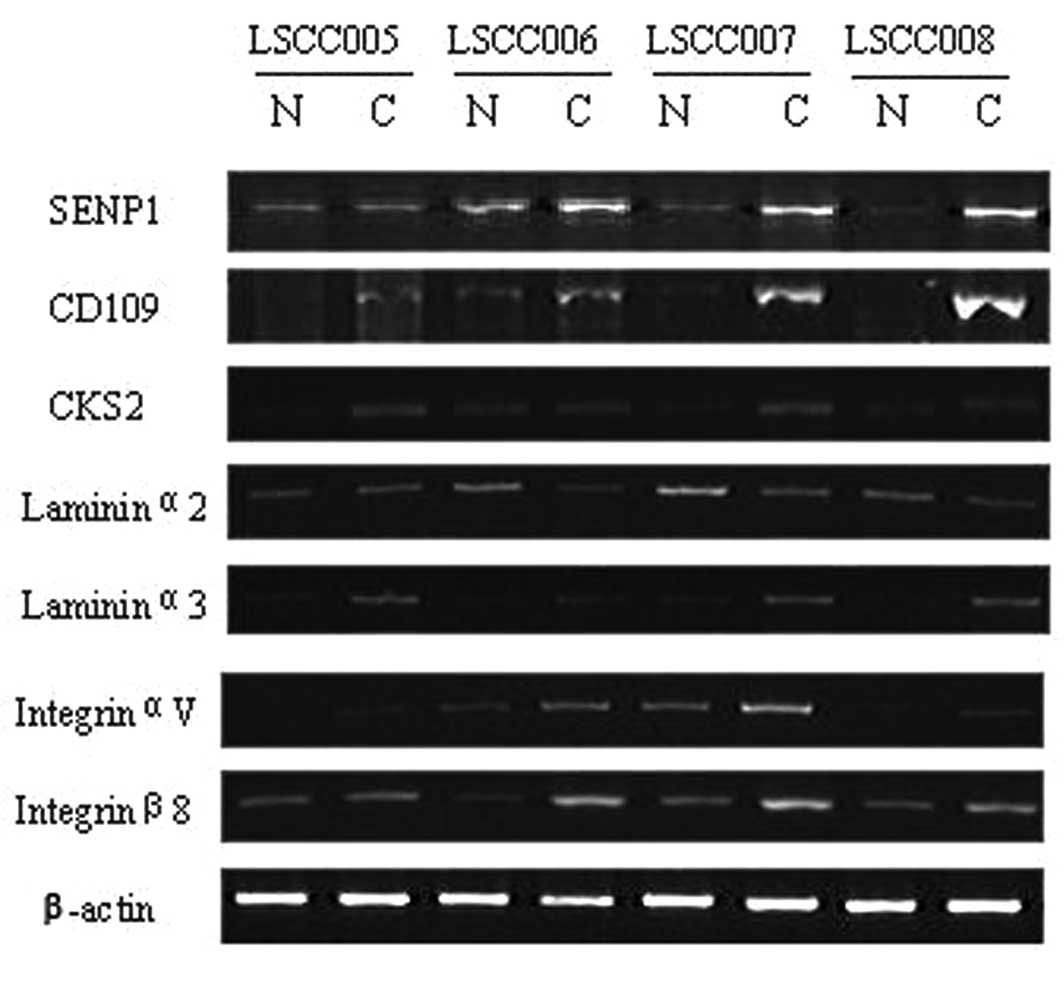Detection of differentially expressed genes and association with clinicopathological features in laryngeal squamous cell carcinoma
- Authors:
- Rong Sheng Ni
- Xiaohui Shen
- Xiaoyun Qian
- Chenjie Yu
- Haiyan Wu
- Xia Gao
-
View Affiliations
Affiliations: Department of Otorhinolaryngology Head and Neck Surgery, BenQ Medical Center, Nanjing Medical University, Nanjing 210019, P.R. China, Department of Otorhinolaryngology Head and Neck Surgery, Nanjing Drum Tower Hospital Affiliated with Nanjing University School of Medicine, Nanjing 210008, P.R. China, Department of Otorhinolaryngology Head and Neck Surgery, Nanjing Drum Tower Hospital Affiliated with Nanjing University School of Medicine, Nanjing 210008, P.R. China
- Published online on: September 18, 2012 https://doi.org/10.3892/ol.2012.920
-
Pages:
1354-1360
Metrics:
Total
Views: 0 (Spandidos Publications: | PMC Statistics:
)
Metrics:
Total PDF Downloads: 0 (Spandidos Publications: | PMC Statistics:
)
This article is mentioned in:
Abstract
Head and neck cancer is a significant health problem worldwide. Early detection and prediction of prognosis will improve patient survival and quality of life. The aim of this study was to identify genes differentially expressed between laryngeal cancer and the corresponding normal tissues as potential biomarkers. A total of 36 patients with laryngeal squamous cell carcinoma were recruited. Four of these cases were randomly selected for cDNA microarray analysis of the entire genome. Using semi-quantitative RT-PCR and western blot analysis, the differential expression of genes and their protein products, respectively, between laryngeal cancer tissues and corresponding adjacent normal tissues was verified in the remaining 32 cases. The expression levels of these genes and proteins were investigated for associations with clinicopathological parameters taken from patient data. The cDNA microarray analysis identified 349 differentially expressed genes between tumor and normal tissues, 112 of which were upregulated and 237 were downregulated in tumors. Seven genes and their protein products were then selected for validation using RT-PCR and western blot analysis, respectively. The data demonstrated that the expression of SENP1, CD109, CKS2, LAMA3, ITGAV and ITGB8 was increased, while LAMA2 was downregulated in laryngeal cancer compared with the corresponding normal tissues. Associations between the expression of these genes and clinicopathological data from the patients were also established, including age, tumor classification, stage, differentiation and lymph node metastasis. Our current study provides the first evidence that these seven genes may be differentially expressed in laryngeal squamous cell carcinoma and also associated with clinicopathological data. Future study is required to further confirm whether detection of their expression can be used as biomarkers for prediction of patient survival or potential treatment targets.
View References
|
1.
|
BW StewartP KleihuesWorld Cancer
ReportInternational Agency for Research on
CancerGeneva2322362003
|
|
2.
|
R MehrotraS YadavOral squamous cell
carcinoma: etiology, pathogenesis and prognostic value of genomic
alterationsIndian J
Cancer436066200610.4103/0019-509X.2588616790942
|
|
3.
|
S TaylorM WakemG DijkmanM AlsarrajM
NguyenA practical approach to RT-qPCR-publishing data that conform
to the MIQE
guidelinesMethods50S1S5201010.1016/j.ymeth.2010.01.00520215014
|
|
4.
|
RT HaySUMO-specific proteases: a twist in
the tailTrends Cell
Biol17370376200710.1016/j.tcb.2007.08.00217768054
|
|
5.
|
Y XuJ LiY ZuoJ DengLS WangGQ
ChenSUMO-specific protease 1 regulates the in vitro and in vivo
growth of colon cancer cells with the upregulated expression of CDK
inhibitorsCancer
Lett3097884201110.1016/j.canlet.2011.05.01921669491
|
|
6.
|
J ChengX KangS ZhangET YehSUMO-specific
protease1 is essential for stabilization of HIF1a during
hypoxiaCell131584595200710.1016/j.cell.2007.08.04517981124
|
|
7.
|
T Bawa-KhalfeET YehSUMO losing balance:
SUMO proteases disrupt SUMO homeostasis to facilitate cancer
development and progressionGenes
Cancer1748752201010.1177/194760191038255521152235
|
|
8.
|
T Bawa-KhalfeJ ChengZ WangET YehInduction
of the SUMO-specific protease 1 transcription by the androgen
receptor in prostate cancer cellsJ Biol
Chem2823734137349200710.1074/jbc.M70697820017932034
|
|
9.
|
M HasegawaS MoritaniY MurakumoT SatoS
HagiwaraC SuzukiS MiiM JijiwaA EnomotoN AsaiS IchiharaM
TakahashiCD109 expression in basal-like breast carcinomaPathol
Int58288294200810.1111/j.1440-1827.2008.02225.x
|
|
10.
|
M HagikuraY MurakumoM HasegawaM JijiwaS
HagiwaraS MiiS HagikuraY MatsukawaY YoshinoR HattoriK WakaiS
NakamuraM GotohM TakahashiCorrelation of pathological grade and
tumor stage of urothelial carcinomas with CD109 expressionPathol
Int60735743201010.1111/j.1440-1827.2010.02592.x20946523
|
|
11.
|
JM ZhangM HashimotoK KawaiY MurakumoT
SatoM IchiharaS NakamuraM TakahashiCD109 expression in squamous
cell carcinoma of the uterine cervixPathol
Int55165169200510.1111/j.1440-1827.2005.01807.x15826242
|
|
12.
|
K RotherM DenglJ LorenzK TschöpR
KirschnerJ MössnerK EngelandGene expression of cyclin-dependent
kinase subunit Cks2 is repressed by the tumor suppressor p53 but
not by the related proteins p63 or p73FEBS
Lett58111661172200710.1016/j.febslet.2007.02.028
|
|
13.
|
Y LanY ZhangJ WangC LinMM IttmannF
WangAberrant expression of Cks1 and Cks2 contributes to prostate
tumorigenesis by promoting proliferation and inhibiting programmed
cell deathInt J Cancer123543551200810.1002/ijc.2354818498131
|
|
14.
|
M LiYM LinS HasegawaT ShimokawaK MurataM
KameyamaO IshikawaT KatagiriT TsunodaY NakamuraY FurukawaGenes
associated with liver metastasis of colon cancer, identified by
genome-wide cDNA microarrayInt J Oncol24305312200414719106
|
|
15.
|
Y UchikadoH InoueN HaraguchiK MimoriS
NatsugoeH OkumuraT AikouM MoriGene expression profiling of lymph
node metastasis by oligomicroarray analysis using laser
microdissection in esophageal squamous cell carcinomaInt J
Oncol2913371347200617088971
|
|
16.
|
Y KariyaT MoriC YasudaN WatanabeY KanekoY
NakashimaT OgawaK MiyazakiLocalization of laminin alpha3B chain in
vascular and epithelial basement membranes of normal human tissues
and its down-regulation in skin cancersJ Mol
Histol39435446200810.1007/s10735-008-9183-0
|
|
17.
|
D MalanM ReppelR DobrowolskiW RoellN
SmythJ HeschelerM PaulssonW BlochBK FleischmannLack of laminin
gamma1 in embryonic stem cell-derived cardiomyocytes causes
inhomogeneous electrical spreading despite intact differentiation
and functionStem Cells278899200910.1634/stemcells.2008-0335
|
|
18.
|
D TsurutaH KobayashiH ImanishiK SugawaraM
IshiiJC JonesLaminin-332-integrin interaction: a target for cancer
therapy?Curr Med
Chem1519681975200810.2174/09298670878513283418691052
|
|
19.
|
MA ArnaoutSL GoodmanJP XiongStructure and
mechanics of integrin-based cell adhesionCurr Opin Cell
Biol19495507200710.1016/j.ceb.2007.08.00217928215
|
|
20.
|
Z Zhao-YangX Ke-SenH Qing-SiN Wei-BoW
Jia-YongM Yue-TangW Jin-ShenW Guo-QiangY Guang-YunN JunSignaling
and regulatory mechanisms of integrin alphavbeta6 on the apoptosis
of colon cancer cellsCancer
Lett266209215200810.1016/j.canlet.2008.02.05418381232
|
|
21.
|
J LiH TanX DongZ XuC ShiX HanH JiangGW
KrissansenX SunAntisense integrin alphaV and beta3 gene therapy
suppresses subcutaneously implanted hepatocellular carcinomasDig
Liver Dis39557565200710.1016/j.dld.2007.01.025
|
|
22.
|
JM ProctorK ZangD WangR WangLF
ReichardtVascular development of the brain requires beta8 integrin
expression in the neuroepitheliumJ
Neurosci2599409948200510.1523/JNEUROSCI.3467-05.200516251442
|












